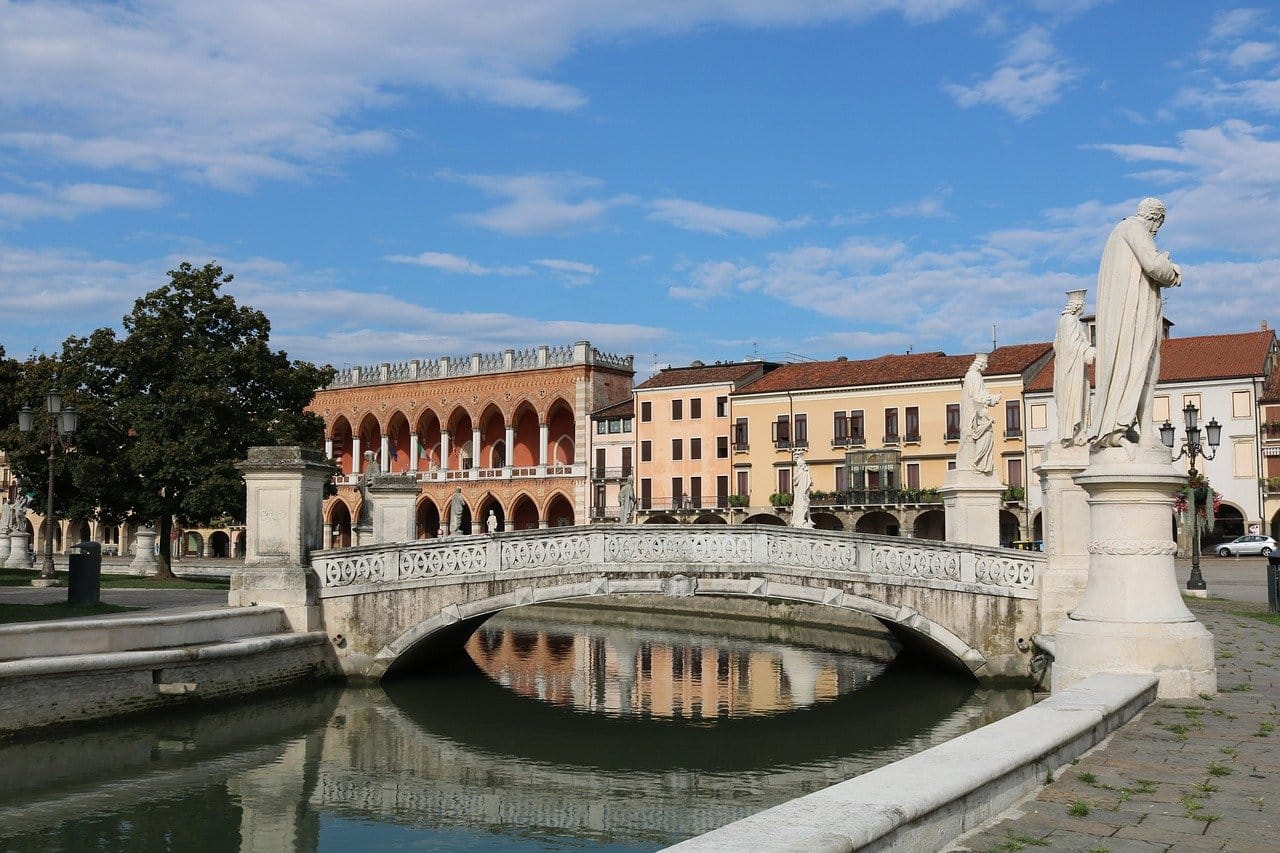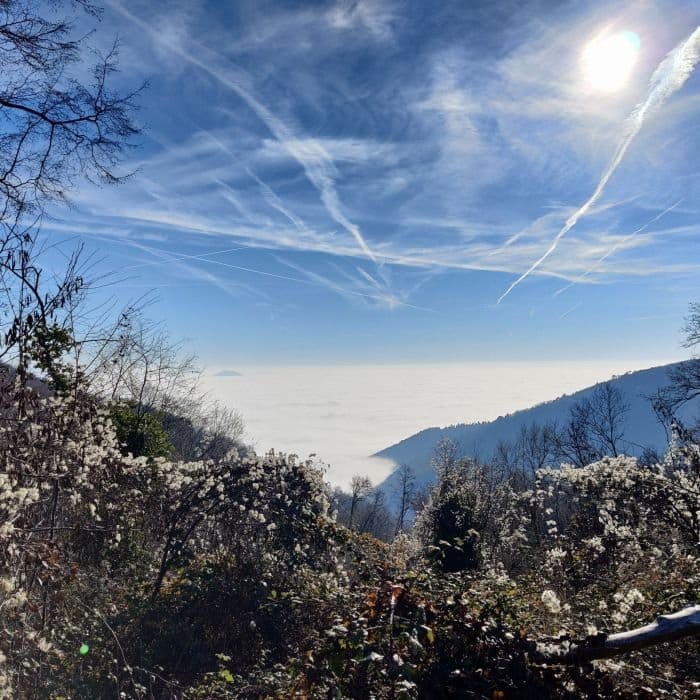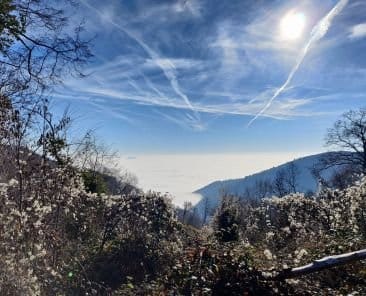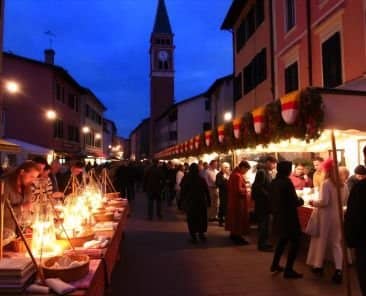Padua, an attractive city in Northern Italy’s Veneto region, is special in many ways. According to the legend, it is said to be one of the oldest cities in this area, dating back to around 1183 BC. Antenor, a prince from Troy, founded it after the fall of Troy when he led a group of Trojans and their allies who settled in Italy.
Padua developed over time through flourishing as well as repelling invasions. From 49 BC onwards it was known as a Roman city and continued flourishing during the Roman Empire as a center for learning and culture, until practically razed to the ground by Attila and his Huns, in the final moments of the Western Roman Empire (these sad circumstances had a silver lining: people fleeing the barbarian hordes in mainland Veneto were the original founders of what came to be Venice).
Throughout its long history, Padua has been home to notable figures like Giotto, a famous Renaissance artist, and Galileo Galilei who taught at Padua university.
The city boasts stunning architecture from different eras including Roman ruins, Gothic cathedrals, and beautiful Renaissance palaces among others. It is also possible for visitors to explore landmarks such as the Basilica of Saint Anthony and Palazzo della Ragione, besides experiencing a vibrant market scene while tasting delicious local dishes like risotto and polenta.
Nowadays Padua is a thriving industrial hub with a diverse economy that includes manufacturing and biotechnology. Padua University which was established in 1222 ranks amongst Europe’s oldest institutions attracting students from across the globe into its renowned faculties within medicine and humanities.
Architectural and Market Highlights
Located at the Piazza delle Erbe in Padua are lovely stone arcades which enclose the square. Piazza delle Erbe has a stunning stone arcade that softly frames its sides.
Palazzo della Ragione, placed between the market squares Piazza delle Erbe and Piazza della Frutta, is an architectural marvel; not just on account of its expansive dome, but especially for its murals showing zodiac signs, recognised by UNESCO. For centuries, Piazza delle Erbe has been a vibrant marketplace and social center in Padua. The square has served as a marketplace since the Middle Ages where merchants gathered to sell various goods including fresh food, spices, herbs, and crafts. This long history of the market helps shape Padua’s cultural identity by displaying its tradition of trade, community, and culinary excellence.
The Palazzo della Ragione in Padua is famous for its remarkable architecture. The largest roof unsupported by columns in Europe is found on the uppermost floor.
Prato della Valle in Padua is an elliptical piazza covering approximately 90,000 square metres; it is Italy’s second largest square after Rome’s St Peter’s Square, and one of Europe’s largest squares as well.
This square is not only vast but also famous for its charm that attracts many people through its breathtaking environment, thanks to dozens of statues of notables from ages past, arranged in a circle around a moat. Nicknamed the “meadow without grass”, Prato della Valle is a stunning destination for locals strolling, having an ice cream, and students pic-nicking at all times of the day (and night).
Another famous square is Piazza dei Signori, filled with unique structures like the magnificent astronomical clock. The clock symbolises how time passes and celestial motions change.
It has a movement system that uses gears to observe celestial objects such as the moon, sun, and stars based on astrological or astronomical principles. Interestingly, it closely resembles the astronomical clock in St. Mark’s Square – for good reason: it was built by the same family of craftsmen.
Nearby, Piazza Capitaniato hosts the Liviano, a large Fascist-era building that hosts part of the University of Padua. Art lovers will love the 1930s murals and statues, but the gold nugget is probably to be found in the library, with furniture created by the celebrated designer Giò Ponti.
While we’re talking about the University of Padua, it is definitely worth visiting Palazzo Bo’, where the rector and some administrative buildings reside. Built progressively over more than half a millennium, the Bo’ has an impressive central courtyard where family crests of medieval students are displayed. Organised by country of origin, these symbols tell the tale of a university that attracted students all the way from Scotland to Cyprus throughout its 800-year history.
Unique Historical Aspects
Located beside Palazzo della Ragione, the Pietra del Vituperio, or “Stone of Shame,” is a black porphyry rock that dates back to 1231. In medieval times, it was used in public acts like humiliation or punishment especially when it came to debtors unable to meet their financial obligations. The stone would be placed at strategic places within public places such as market squares so that insolvent people would be shamed thus others would not be engaged in similar acts of irresponsibility. The punishment itself was peculiar: the insolvent debtor would be lifted by a rope, and dropped so that their buttocks would be struck by the stone. The artistic lore around Padua is often filled with amusing stories and exaggerated tales about individuals who fell into terrible financial straits and had no other option than to confront the Stone of Shame.
Padua occupies a special place among William Shakespeare’s works, in particular in his comedy The Taming of the Shrew. Though there is no hard evidence that links any specific historic house of Padua to this play, the city’s rich cultural heritage and beauty significantly influenced the writer’s fictional setting.
A trip to one of the historical homes in Padua allows travelers to delve into Shakespeare’s imagined description of the city and feel it much like he might have done.
Shakespearean playwrights and artists from England were captivated by Italy during Shakespeare’s era because it had a rich culture, history, and beautiful landscapes.. Padua was regarded as one of Europe’s oldest and most prestigious university towns, symbolizing learning, tradition, and scholarship. Padua is listed as the setting for many plays by Shakespeare, with two notable examples being The Taming of The Shrew and The Merchant Of Venice, vividly portrayed as a bustling center for commerce, academics, and passion.
Culinary Journey
As evidenced by its open air fruit and vegetable markets, open practically every day of the year, fresh vegetables, herbs, meats, and cheeses are key ingredients in Padua’s food culture. These busy markets such as Piazza delle Erbe in Padua have a distinctive assortment of fresh fruits and vegetables, cured meats sold by artisans plus specialty ingredients that inspire home cooks as well as chefs all over town.
Must-try dishes that are renowned in Padua are Bigoli – a kind of thick spaghetti, traditionally enjoyed with duck-based sauce -, Risotto alla Padovana, Baccalà alla Vicentina (though originally a dish from Vicenza), and Spritz. The world-famous drink originated right in this city.
Educational and Botanical Heritage
Padua stands as a testament to the enduring power of knowledge through the pursuit of knowledge in academia. The University of Padua boasts a rich history as it is home to the world-famous Botanical Gardens that continue to be an inspiration to scholars, scientists, and thinkers spanning several generations since its inception.
The University of Padua was founded in 1222 and is among the oldest universities on earth with a long history of pioneering contributions in scholarship, science, and education. The place has always been an educational hub attracting students from all walks of life.
Some well-known alumni include Galileo Galilei, Andreas Vesalius, and Elena Cornaro Piscopia, the first woman graduate in the world.
The Botanical Gardens at the University of Padua are the world’s oldest university-linked botanical gardens, established in 1545. During the Age of Exploration, these gardens collected rare specimens including exotic ones from all around the globe. Learning about plant growth, historical plants as well as tropical greenhouses can be done using a tour provided by Botanical Gardens where we will also get to know that this institution has for so long cherished interest in botany research and conservation.
Conclusion
Our exploration of Padua has been a delightful journey through its rich tapestry of architecture, history, and cuisine. From its legendary beginnings to its vibrant market squares and awe-inspiring structures, Padua enchants with its timeless allure.
These architectural feats demonstrate the rich history of Padua, spanning the Roman, Gothic, and Renaissance periods. The cultural and artistic heritage of Padua is embodied in such landmarks as the Basilica of Saint Anthony or Palazzo della Ragione, while Piazza delle Erbe or Prato della Valle serve as lively marketplaces.
The food scene in Padua highlights local ingredients and regional flavors thereby reflecting deep-rooted tradition and attachment to the land.
Was this helpful?
Good job! Please give your positive feedback
How could we improve this post? Please Help us.


















